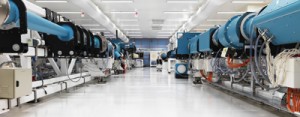 This just in for news of big scary machines of physics–something called, innocently enough, the Extreme Light Infrastructure.
This just in for news of big scary machines of physics–something called, innocently enough, the Extreme Light Infrastructure.
The ELI is a very powerful laser array that will concentrate 200 petawatts of laser power into a very small space-time in hopes of distorting the vacuum on the quantum scale. Let me unpack this a bit to make plain just powerful this is. All the energy from the Sun that falls on the Earth, expressed in units of power, is roughly 89 petawatts, or 89 quadrillion watts. This solar energy is roughly 6000 times the energy produced and consumed by humanity. The ELI expends over the length of a femtosecond and within a space smaller than a pinhead, more than 100,000 times the power of the entire world’s electricity production. How this is possible for us, I shall explain shortly.
So what the hell is this thing for? By concentrating all that energy into such a tiny space, what we hope to do is distort an empty–and I use the word “empty” in a highly qualified way–region of space-time strongly enough to force the emergence of matter and antimatter particles. In this microscopic inferno it’s going to get far hotter than the center of the Sun. It will look as if we generating matter and antimatter from nothing. This might seem incredible but actually it’s all based a very well understood, if counterintuitive, aspect of quantum mechanics.
In quantum mechanics a vacuum is not really empty. Instead it’s something like a sea of boiling particles and antiparticles that constantly emerge from space-time itself only to collide together and annihilate into photos of light. This happens continuously and these virtual particle and antiparticle pairs usually appear and annihilate so quickly and in such a way that they almost never have noticeable effects at the sizes and energies we human experience in daily life. We don’t see matter or energy coming from nothing. But on the quantum scale and at huge energies, the concept of nothing vanishes. Space-time itself is never really a vacuum. It’s never an empty stage in which classical physics plays. The idea of a classical vacuum is an illusion. This what we learn in the first half of the Twentieth Century.
Anyway, there are a variety of ways we can force these virtual particle pairs and photons to appear and have effects that we can measure. The ELI is just one way of doing this. It’s the first time we’ve done this with light alone, even though we’ve known for decades that theory said it was possible.
Now if this all works, this experiment has enormous implications and its data can be applied to a lot of questions and applications:
- Why is there so much matter in universe and so little antimatter?
- What is the composition of the mysterious dark matter and dark energy?
- Are there other dimensions dimension beyond the 4 we know?
- Are some of the predictions of some forms of string theory true?
- Will it give us new and better ways to understand the dynamics of plasmas?
- Will it give us new and better ways to treat some forms of nuclear waste?
- Will it give us new and better methods of radiography and radiotherapy in medicine?
- Will it give us new and better ways to fabricate microelectronics and computer chips.
But to me, one of the big attractions is how gigantic, robust and scary looking this machine is. As I’ve commented before, physics builds some seriously scary looking machines. And with the usual dumbfoundingly understated hyperbole we come to associate with modern science, it’s just called the Extreme Light Infrastructure–as if it were a small bolt on a hang glider or something.
